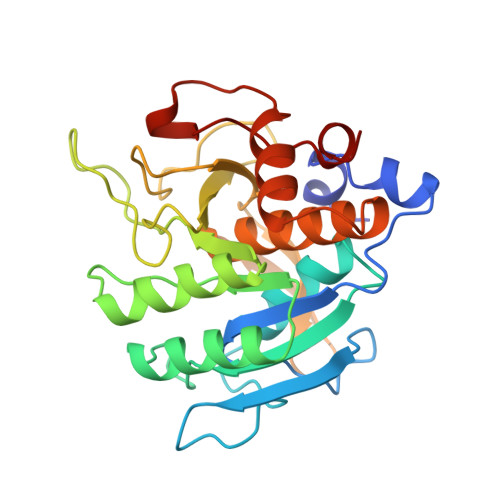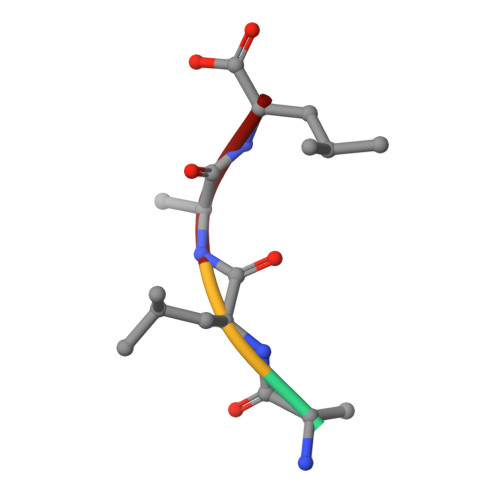Crystal structure of calcium-independent subtilisin BPN' with restored thermal stability folded without the prodomain.
Almog, O., Gallagher, T., Tordova, M., Hoskins, J., Bryan, P., Gilliland, G.L.(1998) Proteins 31: 21-32
- PubMed: 9552156
- DOI: https://doi.org/10.1002/(sici)1097-0134(19980401)31:1<21::aid-prot3>3.0.co;2-k
- Primary Citation of Related Structures:
1SUA - PubMed Abstract:
The three-dimensional structure of a subtilisin BPN' construct that was produced and folded without its prodomain shows the tertiary structure is nearly identical to the wild-type enzyme and not a folding intermediate. The subtilisin BPN' variant, Sbt70, was cloned and expressed in Escherichia coli without the prodomain, the 77-residue N-terminal domain that catalyzes the folding of the enzyme into its native tertiary structure. Sbt70 has the high-affinity calcium-binding loop, residues 75 to 83, deleted. Such calcium-independent forms of subtilisin BPN' refold independently while retaining high levels of activity [Bryan et al., Biochemistry, 31:4937-4945, 1992]. Sbt70 has, in addition, seven stabilizing mutations, K43N, M50F, A73L, Q206V, Y217K, N218S, Q271E, and the active site serine has been replaced with alanine to prevent autolysis. The purified Sbt70 folded spontaneously without the prodomain and crystallized at room temperature. Crystals of Sbt70 belong to space group P2(1)2(1)2(1) with unit cell parameters a = 53.5 A, b = 60.3 A, and c = 83.4 A. Comparison of the refined structure with other high-resolution structures of subtilisin BPN' establishes that the conformation of Sbt70 is essentially the same as that previously determined for other calcium-independent forms and that of other wild-type subtilisin BPN' structures, all folded in the presence of the prodomain. These findings confirm the results of previous solution studies that showed subtilisin BPN' can be refolded into a native conformation without the presence of the prodomain [Bryan et al., Biochemistry 31:4937-4945, 1992]. The structure analysis also provides the first descriptions of four stabilizing mutations, K43N, A73L, Q206V, and Q271E, and provides details of the interaction between the enzyme and the Ala-Leu-Ala-Leu tetrapeptide found in the active-site cleft.
Organizational Affiliation:
Center for Advanced Research in Biotechnology of the University of Maryland Biotechnology Institute and the National Institute of Standards and Technology, Rockville 20850, USA.















